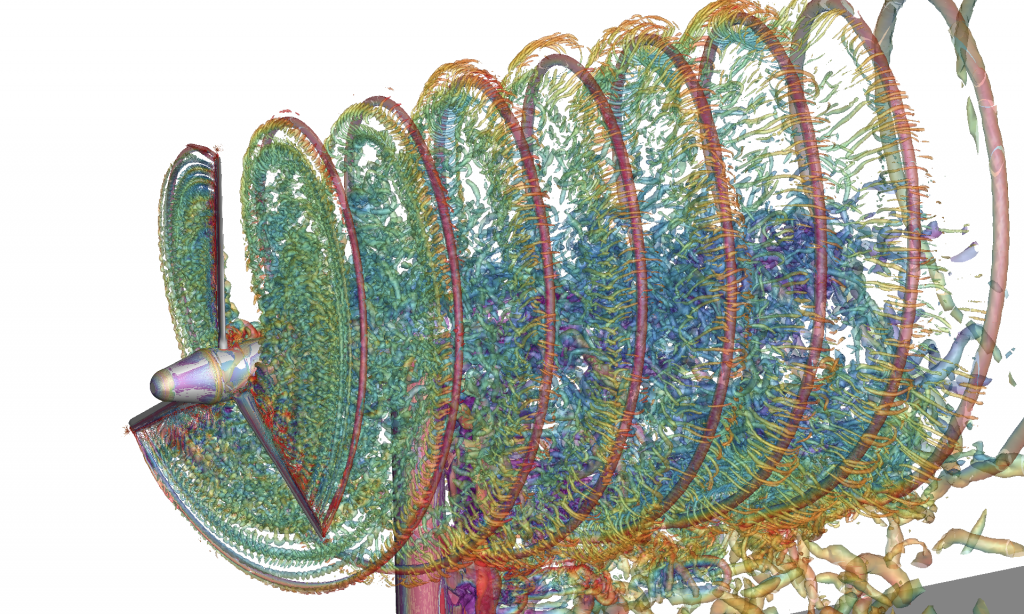Rotor Aerodynamics

Steady and unsteady CFD simulation of wind turbines
To analyze the aerodynamics of a wind turbine is not just important for the energy production but also important for loads and fatigue. As the wind turbines are rising in size and power output, measurements of the aerodynamics are often not possible or too expensive. Therefore numerical methods are used to identify the wind turbine aerodynamics. For this purpose a CFD based process chain was developed and applied at the Institute of Aerodynamics and Gas Dynamics (IAG), University of Stuttgart. The process chain consists of a grid generator with scripting capability for automated meshing, the block structured flow solver FLOWER, which is provided by the German Aerospace Center (DLR) and optional of a multibody simulation for aeroelastic simulations.
Interaction with turbulent inflow and turbine wakes
The atmospheric boundary layer has a significant impact on the blade aerodynamics. Therefore the used CFD-code has been extended by an unsteady inlet boundary condition. This condition allows to set time depended boundary layer conditions. Because of this it is possible to simulate wind turbines under more realistic atmospheric conditions (wind speed distribution, density and turbulence) and to determine the interaction between the atmospheric boundary layer including resolved turbulence and the wind turbine as well as the wake of the turbine.
Highly resolved CFD wake simulations
There is an increasing interest in the numerical simulation of the unsteady aerodynamics and the determination of the interaction between wake and turbulent atmospheric boundary layer to investigate the effect on the inflow conditions of following wind turbines, the loads and their fluctuations. To do so, the wake is highly resolved and simulated with methods of higher order.

Airfoil design and wind tunnel verification
The aerodynamic properties of a rotor blade and therefore the efficiency of the wind turbines are significantly influenced by the design of the airfoils. The IAG has a long-year experience in aerodynamic and acoustic design of airfoils for the use in wind energy applications and in the assessment of airfoils. The airfoils are specifically designed for the requirements of the considered wind turbine. A verification of the theoretical results can be made at the Laminar Wind Tunnel of the Institute, which has a very low turbulence level. As well as polar, pressure distribution and boundary layer measurements, aeroacoustic measurements can be performed using the CPV method. Measurements performed at the Wind Tunnel are also used for the improvement of the airfoil design and analyse methods.
- Analysis, design and numerical optimization of airfoils
- Aeroacoustic design of silent airfoils
- Development of prediction models
- Boundary Layer Methods, Transition detection, Modelling of laminar separation bubbles
- Noise prediction tools
- Optimization methods
- Wind Tunnel measurements
- Fabrication of wind tunnel models
- Aerodynamic measurements (polar, pressure distribution and boundary layer measurements)
- Aeroacoustic measurements
- AssiSt (CFD simulations of wind turbines in complex terrain)
- AVATAR (CFD studies on the impact of inflow turbulence on wind turbines)
- DFG research focus PAK 780 (Numerical studies on the adaptive camber load control concept for wind turbines)
- InnWind (CFD studies on active trailing edge flaps for load control)
- KonTest (Assessment of complex terrain sites for research wind turbines)
- LARS (Numerical studies on a novel passive load control concept for wind turbines on the example of a two bladed machine)
- LiDAR Complex (Time-resolved flow simulations of wind turbines in complex terrain)
- IEA Annex MexNext III (Validation of aerodynamic and aeroacoustic codes for wind turbines)
- OWEA Loads (Simulation of interacting offshore wind turbines)

